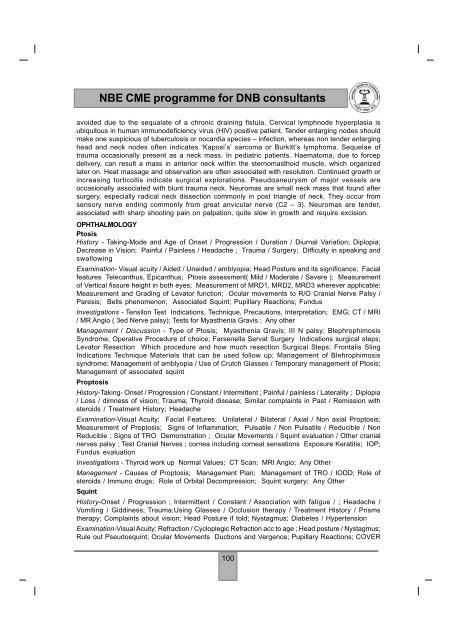NBE CME programme for DNB consultants - National Board Of ...
NBE CME programme for DNB consultants - National Board Of ...
NBE CME programme for DNB consultants - National Board Of ...
Create successful ePaper yourself
Turn your PDF publications into a flip-book with our unique Google optimized e-Paper software.
<strong>NBE</strong> <strong>CME</strong> <strong>programme</strong> <strong>for</strong> <strong>DNB</strong> <strong>consultants</strong>avoided due to the sequalate of a chronic draining fistula. Cervical lymphnode hyperplasia isubiquitous in human immunodeficiency virus (HIV) positive patient. Tender enlarging nodes shouldmake one suspicious of tuberculosis or nocardia species – infection, whereas non tender enlarginghead and neck nodes often indicates ‘Kaposi’s’ sarcoma or Burkitt’s lymphoma. Sequelae oftrauma occasionally present as a neck mass. In pediatric patients. Haematoma, due to <strong>for</strong>cepdelivery, can result a mass in anterior neck within the sternomasthoid muscle, which organizedlater on. Heat massage and observation are often associated with resolution. Continued growth orincreasing torticollis indicate surgical explorations. Pseudoaneurysm of major vessels areoccasionally associated with blunt trauma neck. Neuromas are small neck mass that found aftersurgery, especially radical neck dissection commonly in post triangle of neck. They occur fromsensory nerve ending commonly from great anvicular nerve (C2 – 3). Neuromas are tender,associated with sharp shooting pain on palpation, quite slow in growth and require excision.OPHTHALMOLOGYPtosisHistory - Taking-Mode and Age of Onset / Progression / Duration / Diurnal Variation; Diplopia;Decrease in Vision; Painful / Painless / Headache ; Trauma / Surgery; Difficulty in speaking andswallowingExamination- Visual acuity / Aided / Unaided / amblyopia; Head Posture and its significance; Facialfeatures Telecanthus, Epicanthus; Ptosis assessment( Mild / Moderate / Severe ); Measurementof Vertical fissure height in both eyes; Measurement of MRD1, MRD2, MRD3 wherever applicable;Measurement and Grading of Levator function; Ocular movements to R/O Cranial Nerve Palsy /Paresis; Bells phenomenon; Associated Squint; Pupillary Reactions; FundusInvestigations - Tensilon Test Indications, Technique, Precautions, Interpretation; EMG; CT / MRI/ MR Angio ( 3ed Nerve palsy); Tests <strong>for</strong> Myasthenia Gravis ; Any otherManagement / Discussion - Type of Ptosis; Myasthenia Gravis; III N palsy; BlephrophimosisSyndrome; Operative Procedure of choice; Farsenella Servat Surgery Indications surgical steps;Levator Resection Which procedure and how much resection Surgical Steps; Frontalis SlingIndications Technique Materials that can be used follow up; Management of Blehrophimosissyndrome; Management of amblyopia / Use of Crutch Glasses / Temporary management of Ptosis;Management of associated squintProptosisHistory-Taking- Onset / Progression / Constant / Intermittent ; Painful / painless / Laterality ; Diplopia/ Loss / dimness of vision; Trauma; Thyroid disease; Similar complaints in Past / Remission withsteroids / Treatment History; HeadacheExamination-Visual Acuity; Facial Features; Unilateral / Bilateral / Axial / Non axial Proptosis;Measurement of Proptosis; Signs of Inflammation; Pulsatile / Non Pulsatile / Reducible / NonReducible ; Signs of TRO Demonstration ; Ocular Movements / Squint evaluation / Other cranialnerves palsy ; Test Cranial Nerves ; cornea including corneal sensations Exposure Keratitis; IOP;Fundus evaluationInvestigations - Thyroid work up Normal Values; CT Scan; MRI Angio; Any OtherManagement - Causes of Proptosis; Management Plan; Management of TRO / IODD; Role ofsteroids / Immuno drugs; Role of Orbital Decompression; Squint surgery; Any OtherSquintHistory-Onset / Progression ; Intermittent / Constant / Association with fatigue / ; Headache /Vomiting / Giddiness; Trauma;Using Glasses / Occlusion therapy / Treatment History / Prismstherapy; Complaints about vision; Head Posture if told; Nystagmus; Diabetes / HypertensionExamination-Visual Acuity; Refraction / Cycloplegic Refraction acc to age ; Head posture / Nystagmus;Rule out Pseudosquint; Ocular Movements Ductions and Vergence; Pupillary Reactions; COVER100
















